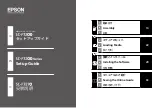
Minimizing your printer's environmental
impact
We are committed to environmental sustainability and are continually improving our printers to reduce their impact
on the environment.
Saving paper and toner
Studies show that as much as 80% of the carbon footprint of a printer is related to paper usage. You can significantly
reduce your carbon footprint by using recycled paper and the following printing suggestions, such as printing on
both sides of the paper and printing multiple pages on one side of a single sheet of paper.
For information on how you can quickly save paper and energy using one printer setting, see "Using Eco-Mode".
Using recycled paper and other office papers
As an environmentally conscientious company, we support the use of recycled paper produced specifically for use
in laser (electrophotographic) printers.
While no blanket statement can be made that all recycled paper will feed well, we consistently test papers that
represent recycled cut size copier papers available on the global market. This scientific testing is conducted with
rigor and discipline. Many factors are taken into consideration both separately and as a whole, including the following:
•
Amount of post-consumer waste (We test up to 100% post-consumer waste content.)
•
Temperature and humidity conditions (Testing chambers simulate climates from all over the world.)
•
Moisture content (Business papers should have low moisture: 4–5%.)
•
Bending resistance and proper stiffness means optimum feeding through the printer.
•
Thickness (impacts how much can be loaded into a tray)
•
Surface roughness (measured in Sheffield units, impacts print clarity and how well toner fuses to the paper)
•
Surface friction (determines how easily sheets can be separated)
•
Grain and formation (impacts curling, which also influences the mechanics of how the paper behaves as it moves
through the printer)
•
Brightness and texture (look and feel)
Recycled papers are better than ever; however, the amount of recycled content in a paper affects the degree of
control over foreign matter. And while recycled papers are one good path to printing in an environmentally
responsible manner, they are not perfect. The energy required to de-ink and deal with additives such as colorants
and “glue” often generates more carbon emissions than does normal paper production. However, using recycled
papers enables better resource management overall.
We concern ourselves with the responsible use of paper in general based on life cycle assessments of its products.
To gain a better understanding of the impact of printers on the environment, the company commissioned a number
of life cycle assessments and found that paper was identified as the primary contributor (up to 80%) of carbon
emissions caused throughout the entire life of a device (from design to end-of-life). This is due to the energy-intensive
manufacturing processes required to make paper.
Thus, we seek to educate customers and partners on minimizing the impact of paper. Using recycled paper is one
way. Eliminating excessive and unnecessary paper consumption is another. We are well-equipped to help customers
Minimizing your printer's environmental impact
39
Summary of Contents for d-Color MF920
Page 1: ...d Color MF920 d Color MF923 OPERATION GUIDE Code 556701en GB...
Page 89: ...3 Connect the answering machine or telephone to the adapter Faxing 89...
Page 174: ...3 Open the top door 4 Remove the right side cover Maintaining the printer 174...
Page 193: ...13 Insert the developer unit 14 Align and insert the imaging kit Maintaining the printer 193...
Page 248: ......
















































